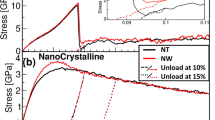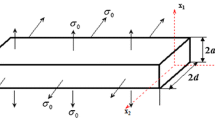Abstract
A stretch-release strategy is proposed to analyze the problem of surface energy-induced stress fields in nanocrystals, which is resolved into a stretch sub-problem and a release sub-problem using the superposition principle. The surface effect of silicon nanowires with hexagonal cross-sections is analyzed by the proposed method. The severe stress concentration near the triple junctions of the wire surfaces and the large shear stress on the plane {111} is quantified, which provides a solid mechanical explanation for the kink phenomena in growth transition from direction 〈111〉 to 〈112〉 observed in experiments. Different from the conventional view of negligible surface effect for bulk material, we found that there exists a size-independent part of the surface effect on the stress in the order of tens or hundreds of mega Pascal, which corresponds to the stretch-induced biaxial stress in the surface layer and the shape influence of the geometry of nanocrystals. This size-independent part could well explain the size-independent kinking phenomenon during the growth of silicon nanowires.

摘要
本文提出一种“拉伸-释放”策略, 将表面能在纳米晶体内引起应力场的问题分解为拉伸子问题和释放子问题. 基于该策略和有限元方法分析了表面能在硅纳米线表面角点附近的应力集中和{111}面上的切应力, 为实验中观察到的硅纳米线生长方向由〈111〉转向〈112〉的扭结现象提供了坚实的力学解释. 与传统的块状材料表面效应可忽略的观点不同, 研究发现, 由于表面层拉伸引起的双轴应力和纳米晶体几何形状的影响, 表面能引起的应力存在与尺寸无关的部分, 其值可达数十至数百兆帕. 这一尺寸无关的表面效应很好地解释了硅纳米线生长扭结与纳米线粗细无关的实验现象.
Similar content being viewed by others
References
G. F. Wang, and X. Q. Feng, Surface effects on buckling of nanowires under uniaxial compression, Appl. Phys. Lett. 94, 141913 (2009).
P. Müller, and A. Saúl, Elastic effects on surface physics, Surf. Sci. Rep. 54, 157 (2004).
H. Ibach, The role of surface stress in reconstruction, epitaxial growth and stabilization of mesoscopic structures, Surf. Sci. Rep. 29, 195 (1997).
X. Zhang, X. Li, and H. Gao, Size and strain rate effects in tensile strength of penta-twinned Ag nanowires, Acta Mech. Sin. 33, 792 (2017).
J. He, and C. M. Lilley, Surface effect on the elastic behavior of static bending nanowires, Nano Lett. 8, 1798 (2008).
J. Zhang, C. Wang, R. Chowdhury, and S. Adhikari, Small-scale effect on the mechanical properties of metallic nanotubes, Appl. Phys. Lett. 101, 093109 (2012).
H. L. Sun, L. Y. Chen, S. Sun, and T. Y. Zhang, Size- and temperature-dependent Young’s modulus and size-dependent thermal expansion coefficient of nanowires, Sci. China Tech. Sci. 61, 687 (2018).
Q. He, and C. M. Lilley, Resonant frequency analysis of Timoshenko nanowires with surface stress for different boundary conditions, J. Appl. Phys. 112, 074322 (2012).
F. Ebrahimi, and S. H. S. Hosseini, Nonlinear dynamics and stability of viscoelastic nanoplates considering residual surface stress and surface elasticity effects: A parametric excitation analysis, Eng. Comput. 37, 1709 (2021).
L. H. Liang, and B. Li, Size-dependent thermal conductivity of nanoscale semiconducting systems, Phys. Rev. B 73, 153303 (2006).
R. N. Sajjad, S. Bhowmick, and Q. D. M. Khosru, in Cross-sectional shape effects on the electronic properties of Silicon nanowires: Proceedings of 2008 IEEE International Conference on Electron Devices and Solid-State Circuits, Hong Kong, 2008, (IEEE, Piscataway, 2009). pp. 1–4.
G. Y. Huang, and S. W. Yu, Effect of surface piezoelectricity on the electromechanical behaviour of a piezoelectric ring, Phys. Stat. Sol. B 243, R22 (2006).
J. Zhang, Small-scale effects on the piezopotential properties of tapered gallium nitride nanowires: The synergy between surface and flexoelectric effects, Nano Energy 79, 105489 (2021).
L. Nela, J. Ma, C. Erine, P. Xiang, T. H. Shen, V. Tileli, T. Wang, K. Cheng, and E. Matioli, Multi-channel nanowire devices for efficient power conversion, Nat. Electron. 4, 284 (2021).
A. Zhang, J. H. Lee, and C. M. Lieber, Nanowire-enabled bioelectronics, Nano Today 38, 101135 (2021).
S. Steinhauer, S. Gyger, and V. Zwiller, Progress on large-scale superconducting nanowire single-photon detectors, Appl. Phys. Lett. 118, 100501 (2021).
J. Um, Y. Zhang, W. Zhou, M. R. Zamani Kouhpanji, C. Radu, R. R. Franklin, and B. J. H. Stadler, Magnetic nanowire biolabels using ferromagnetic resonance identification, ACS Appl. Nano Mater. 4, 3557 (2021).
C. Herring, and W. E. Kingston, The Physics of Powder Metallurgy, W. E. Kingston, Ed. (McGraw Hill, New York, 1951).
R. S. Dunham, and M. E. Gurtin, Surface stress and the equilibrium shape of an elastic crystal, Appl. Phys. Lett. 30, 255 (1977).
M. E. Gurtin, and A. I. Murdoch, Surface stress in solids, Int. J. Solids Struct. 14, 431 (1978).
W. Gao, S. Yu, and G. Huang, Finite element characterization of the size-dependent mechanical behaviour in nanosystems, Nanotechnology 17, 1118 (2006).
S. Mouloodi, J. Khojasteh, M. Salehi, and S. Mohebbi, Size dependent free vibration analysis of multicrystalline nanoplates by considering surface effects as well as interface region, Int. J. Mech. Sci. 85, 160 (2014).
S. Mouloodi, S. Mohebbi, J. Khojasteh, and M. Salehi, Size-dependent static characteristics of multicrystalline nanoplates by considering surface effects, Int. J. Mech. Sci. 79, 162 (2014).
J. Diao, K. Gall, and M. L. Dunn, Surface-stress-induced phase transformation in metal nanowires, Nat. Mater 2, 656 (2003).
L. G. Zhou, and H. Huang, Are surfaces elastically softer or stiffer? Appl. Phys. Lett. 84, 1940 (2004).
Y. Sun, X. Huang, F. Liu, and H. Chu, Equivalent surface energy of nanovoids in metallic crystals, Comput. Mater. Sci. 198, 110680 (2021).
R. Shuttleworth, The surface tension of solids, Proc. Phys. Soc. Sect. A. 63, 444 (1950).
D. Stottmeister, and A. Groß, Strain dependence of metal anode surface properties, ChemSusChem 13, 3147 (2020).
Q. Xu, K. E. Jensen, R. Boltyanskiy, R. Sarfati, R. W. Style, and E. R. Dufresne, Direct measurement of strain-dependent solid surface stress, Nat. Commun. 8, 555 (2017).
S. Stelmakh, K. Skrobas, S. Gierlotka, and B. Palosz, Effect of the surface on the internal structure of CdSe crystal lattice based on molecular dynamics simulations, J. Nanopart. Res. 19, 170 (2017).
D. T. J. Hurle, A mechanism for twin formation during Czochralski and encapsulated vertical Bridgman growth of III-V compound semiconductors, J. Cryst. Growth 147, 239 (1995).
J. Westwater, D. P. Gosain, S. Tomiya, S. Usui, and H. Ruda, Growth of silicon nanowires via gold/silane vapor-liquid-solid reaction, J. Vac. Sci. Technol. B: Microelectron. Nanometer Struct. Proc. Meas. Phenom. 15, 554 (1997).
N. Shin, and M. A. Filler, Controlling silicon nanowire growth direction via surface chemistry, Nano Lett. 12, 2865 (2012).
F. Li, Y. Huang, S. Wang, and S. Zhang, Critical review: Growth mechanisms of the self-assembling of silicon wires, J. Vac. Sci. Tech. A 38, 010802 (2020).
S. A. Dayeh, J. Wang, N. Li, J. Y. Huang, A. V. Gin, and S. T. Picraux, Growth, defect formation, and morphology control of germanium—silicon semiconductor nanowire heterostructures, Nano Lett. 11, 4200 (2011).
M. A. Hopcroft, W. D. Nix, and T. W. Kenny, What is the Young’s modulus of silicon? J. Microelectromech. Syst. 19, 229 (2010).
J. Rabier, and J. L. Demenet, Low temperature, high stress plastic deformation of semiconductors: the silicon case, Phys. Stat. Sol. B 222, 63 (2000).
M. Koto, Growth mechanisms of vapor-liquid-solid grown nanowires: A detailed analysis of irregular nanowire formation, J. Cryst. Growth 391, 72 (2014).
Acknowledgements
This work was supported by the National Natural Science Foundation of China (Grant No. 11872237), the Natural Science Foundation of Shanghai (Grant No. 18ZR1414600), and the Challenging Project from China Academy of Engineering Physics.
Author information
Authors and Affiliations
Contributions
Haijian Chu designed the methodology and performed a formal analysis and verification of the simulation results. Fanwei Liu wrote the first draft of the manuscript and set up the simulation set-up and processed the simulation data. Haijian Chu and Fanwei Liu revised and edited the final version.
Corresponding author
Rights and permissions
About this article
Cite this article
Liu, F., Chu, H. An approach to calculate surface effects of polyhedron nanocrystals and its application in silicon nanowires. Acta Mech. Sin. 38, 122097 (2022). https://doi.org/10.1007/s10409-022-22097-x
Received:
Accepted:
Published:
DOI: https://doi.org/10.1007/s10409-022-22097-x




